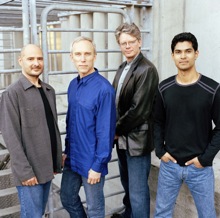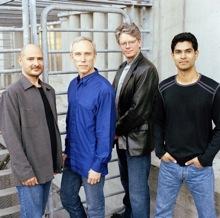The music of Steve Reich and the Kronos Quartet, played at Sunday’s Cal Performances concert in Hertz Hall, helped me understand a verse from Psalm 92 in a new way:
עֲלֵי-עָשׂוֹר, וַעֲלֵי-נָבֶל; עֲלֵי הִגָּיוֹן בְּכִנּוֹר.
(Alei Assor, ve aley nevel, alei higayon b’kinnor.)
– Psalms 92:4
This verse is translated in the King James Bible to read: “upon an instrument of 10 strings, and upon the psaltery; upon the harp with a solemn sound.” The translation of higayon as solemn sound, though, misses much of the depth of the Hebrew word. Higayon is related to the Hebrew words for logic, steering, mental expression, and speech. I have always been fascinated by this verse that describes speech and logical expression played on stringed instruments.

Yet, written letters only convey words and their associations. When we hear speech, much more information is conveyed: tonal inflection, syllabic accents, speed, and so on. Composer Steve Reich has made a career out of recording speech patterns and notating their pitches and rhythms. He takes this to such an exacting level that he has the instruments shadow recorded spoken speech in everything except words. The instruments, in effect, mine speech for all its nonverbal communicative information, taking higayon to an entirely new level.
Whether it be conversation, prayer chant, or noise, Reich finds music in all sound. The selections heard in this Berkeley concert concentrated on particularly dark inspirations: music about trains during the holocaust (a work titled Different Trains), 9/11 and its aftermath (WTC 9/11), and a burial cave in Hebron (The Cave), a place that has been a focal point of spiritual significance and violent conflict. After 9/11 and other tragedies, outbursts of artistic creativity usually follow. The deep and painful scars trigger equally deep responses from artists that can help ease the pain in the form of a catharsis, or can conjure it up again. It is the latter that Reich achieved in WTC 9/11, which took him nearly a decade to get out.
Whether it be conversation, prayer chant, or noise, Reich finds music in all sound.
In all these pieces, Reich layers steady rhythmic foundation under sound effects, recorded speech, and instruments imitating and developing the musical content in that speech. When combined, these achieve a sense of angst and chaos, kept in order by that steady rhythmic foundation.
At the Root
Reich often taps into his Jewish roots in his music. These three pieces all contain connections to Judaism: the trains carrying Jews to the holocaust run on parallel tracks to more innocent trains carrying the young Reich back and forth from New York to Los Angeles (echoed in WTC 9/11, when Reich loops the recorded flight controllers’ talk about the direction that the airplanes were supposed to go); recorded prayers in the Machpela cave, where Abraham and his family were buried; and, in WTC 9/11, quotations from Psalms and descriptions of the Jewish tradition of watching over the dead until buried. This concert took place one day after Yom Kippur, when Jewish religious intensity is traditionally at its highest — a powerful time to present these works.
The canned sound was tinny when compared to [Kronos’] live acoustic quartet sound.
The one selection on the program that had no extramusical associations was Triple Quartet, though its harmonic language and rhythmic intensity were of the same world as the other compositions. Although this all-Reich concert featured music spanning three decades, there is little evidence of change in his style. His musical language stays confidently steady, his technique being based on the same rhythmic principles he typically employs. If anything, the layering in the later pieces become more dense and the electronic effects more sophisticated.
For Triple Quartet, as with the others that require more musicians on stage, the Kronos Quartet was accompanied by recordings of itself. Had another live quartet been invited to participate, the interplay would have been a lot more exciting (surely many local string quartets would have loved to perform with the Kronos). Instead, Kronos played alongside two large speaker towers. Even though Kronos has the highest-fidelity electronic sound production equipment available, the canned sound was tinny when compared to its live acoustic quartet sound. If anything, this served to highlight the differences between the two sound sources. If this was part of the artistic point (playing with a recording of yourself is an interesting dynamic), then it’s well-taken; but it may have been done for expedience. Kronos always plays with amplification, though the presence of live sound makes a huge difference.
As an encore, the quartet played Perotin’s Viderunt omnes, a piece from about 800 years ago (recommended by Reich) from one of the first composers who attached his name to a written musical composition. This ethereal music was of course very different from Reich’s, but had similarities: the breathless, ceaseless repetition of phrases; the use of wide-open harmonies based on drones; and the setting of a transcendental mood, leaving observers to watch time rhythmically tick by.

